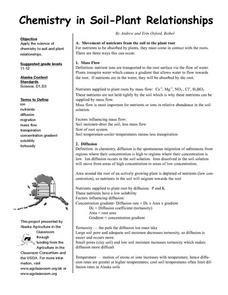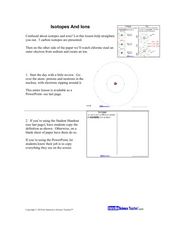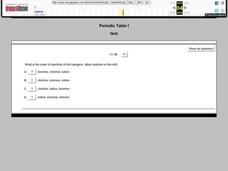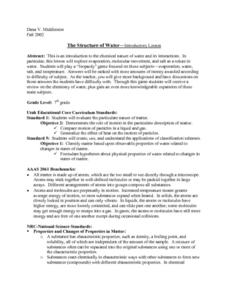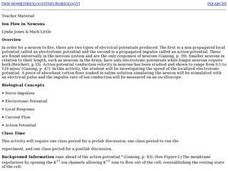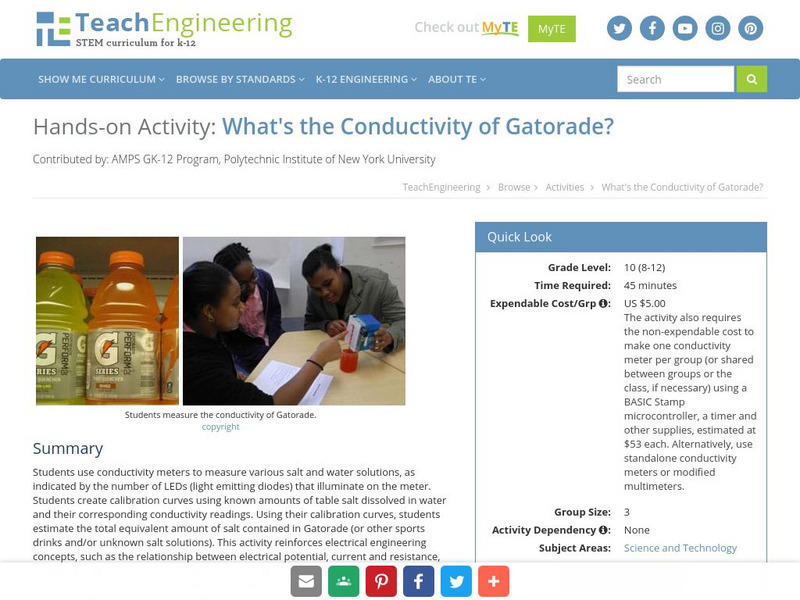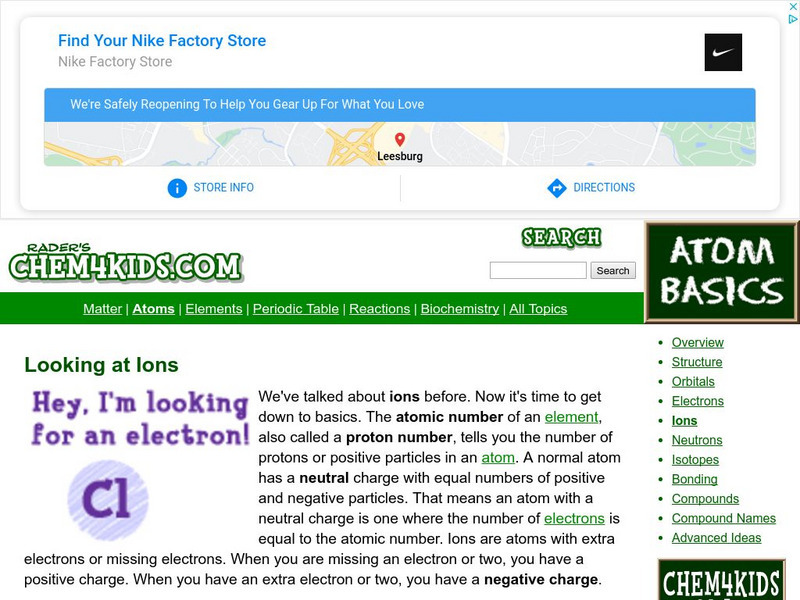Curated OER
Chemistry in Soil-Plant Relationship
Students apply the science of chemistry to soil and plant relationships. They define diffusion and indicate for which of these nutrient(s) would you expect diffusion to be the most important for movement to the plant root? Pupils...
Curated OER
Atomic Structure and Bonding
Eighth graders discuss and write about what led up to the discovery of the atom. Students label proton, nucleus, electron, and neutron in their notes. Students take notes on electron shells and how different atoms have different...
Curated OER
Household Chemistry
Young scholars use indicator paper to determine if substances are acidic, basic, or neutral. They test for Ph levels in them. They investigate the effect of oxygen on darkening fruit cut and exposed to the air. They observe vitamin C as...
Curated OER
Unit 4 - Periodic Table
There are 17 multiple choice questions on this periodic table test. The focus is on properties of the elements by group and period. The exam is not formatted well, making it a little difficult to read. There is also a typographical...
Curated OER
Atom Basics Test
Simple in format and standard in content, this resource is an assessment of your beginning chemists' grasp of the atom. Using a periodic table of elements, they fill in a chart of missing chemical formulas, atomic masses, and numbers of...
Curated OER
Isotopes and Ions
Students examine the concepts of isotopes and atoms. In this powerpoint instructional activity, students see the balance in numbers of protons, neutrons, and electrons create isotopes and ions of certain atoms.
Curated OER
Predicting and Naming Polyatomic Ionic Compounds Worksheet
For this compounds worksheet, students write the polyatomic ionic compound formulas or the compound names. This worksheet has 29 problems to solve.
Curated OER
Periodic Table I Quiz
In this periodic table I quiz, students select the best answer to the given questions. Students apply their knowledge of the periodic table and the arrangement to correctly answer the questions presented.
Curated OER
Acids and Bases
For this acids and bases worksheet, learners will identify the molecules represented in a diagram equation and determine if an acidic or basic solution has been produced. Students will list the properties of acidic and basic solutions....
Curated OER
Lewis Structures
In this Lewis structures worksheet, students identify and describe what Lewis structures or dot diagrams are and how they illustrate the valence electrons in an outer shell. Then they use a periodic table to determine the numbers of...
Curated OER
The Chemical Nature of Water
Seventh graders simulate a Jeopardy game to examine the chemical nature of water. Among the topics featured are evaporation, water, salt, and temperature. finally, as review, 7th graders answer a battery of questions presented by the...
Curated OER
Ions in the Environment
Students explain the importance of the five main biogeochemical cycles. In this chemistry lesson plan, students discuss how ions are transported in the environment. They design an experiment to collect data on eutrophication.
Curated OER
Basic Chemistry Review
Students experiment to show their knowledge of molecules and atomic structures. In this chemistry review lesson students participate in an activity and then fill out a worksheet.
Curated OER
Ion Flow in Neurons
Student perform an experiment in which they determine the velocity of ion flow in an electrotonic potential and compare it to the velocity of action potentials. They record and analyze their results.
Concord Consortium
Concord Consortium: Stem Resources: Electrostatics
This web-based activity takes students through a series of pages in which they find out about the effects charged particles have on one another, discover how Coulomb's force works, and see some real-world examples. Multiple-choice and...
Massachusetts Institute of Technology
Mit: Internet Classics Archive: Works by Plato
A library entry with translations of many works by Plato, including commentary and discussion of each.
PBS
Pbs Newshour Extra: Neuroscience Basics Through Puzzles and Dance
This interesting lesson plans uses giant neutron puzzles, the game of telephone, and dance to explain how transmitters and receptors work in neurotransmission.
Other
Plato and His Dialogues: List of Plato's Works
This list of works by Plato such as The Republic also features links to e-texts in English translation.
TeachEngineering
Teach Engineering: What's the Conductivity of Gatorade?
Students use conductivity meters to measure various salt and water solutions, as indicated by the number of LEDs (light emitting diodes) that illuminate on the meter. Students create calibration curves using known amounts of table salt...
Chem4kids
Chem4 Kids: Ions
Here at Chem4Kids you can learn all about ions. Content explores what an ion is, its various characteristics, electrovalence, and more.
Concord Consortium
Concord Consortium: Stem Resources: Atomic Structure
Introduces learners to atomic models of the past and present, focusing on the orbital model and an explanation of its basis. Learners then have the opportunity to "make an atom" and contrast it with an ion, followed by an isotope. The...
Utah Education Network
Uen: Build an Atom
Students use cereal, marshmallows, and frosting to help them understand the concept of the atom, ion, and isotope, as well as the locations of subatomic particles in the atom, the concept of strong nuclear force.
Utah Education Network
Uen: Classroom Bonding
Students will be assigned an ion "name tag" and move around the classroom finding suitable other "atoms" to bond with.
Massachusetts Institute of Technology
Mit: Internet Classics Archive: Ion
This site from the Internet Classics Archive provides the full text of Plato's dialogue, "Ion." Translated by Benjamin Jowett.


